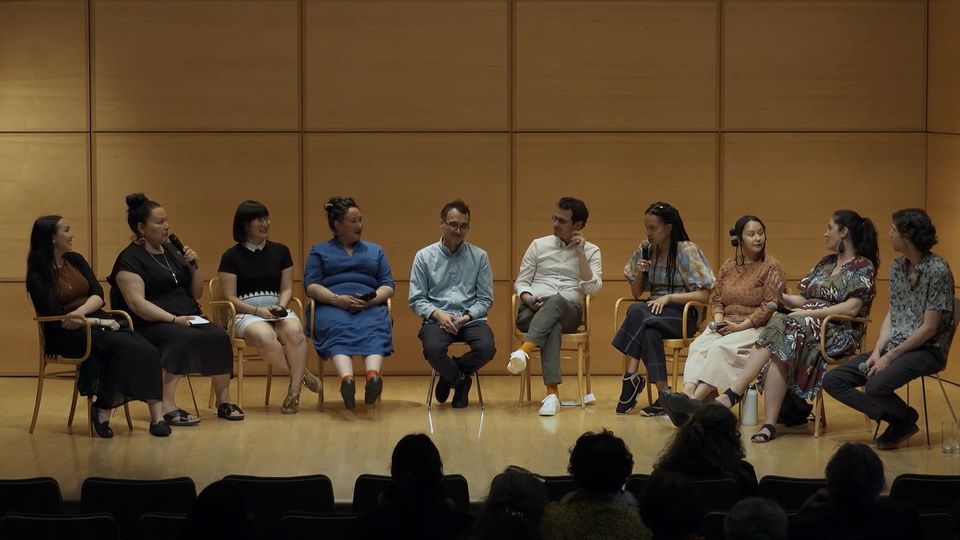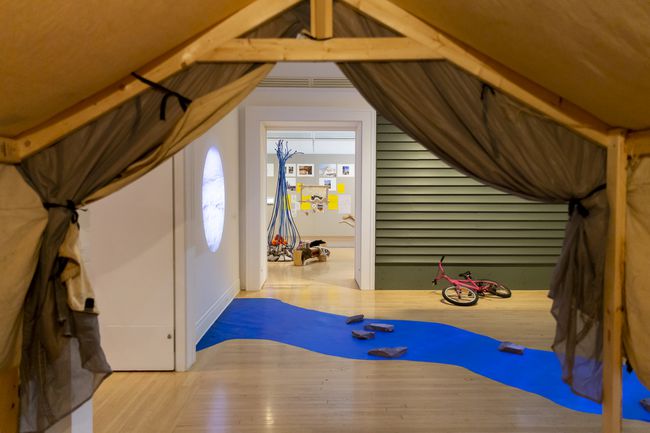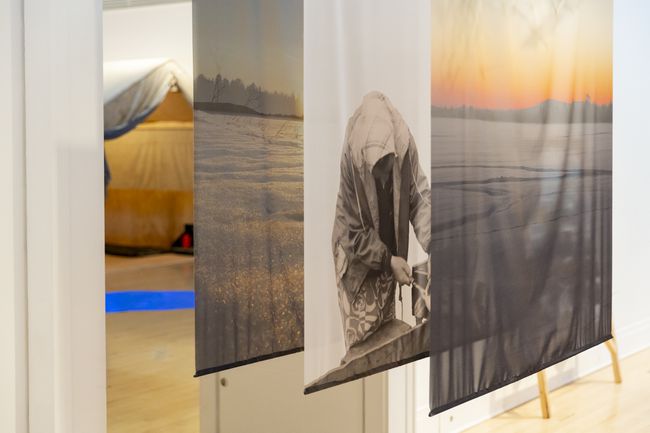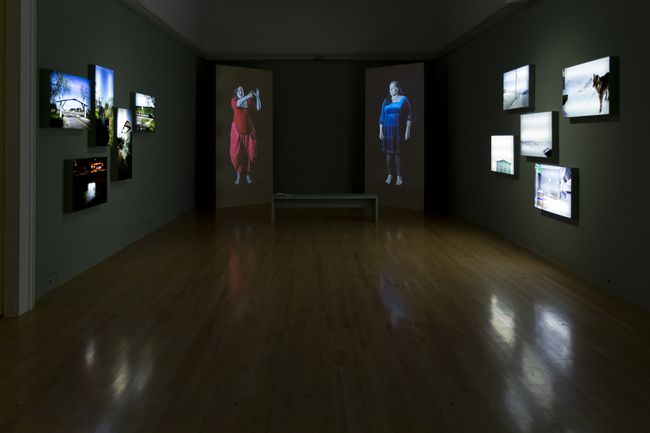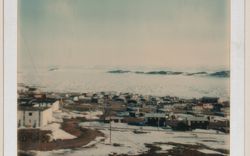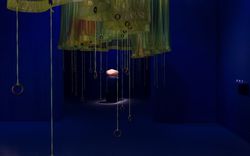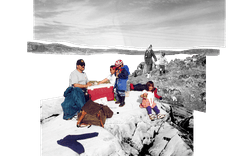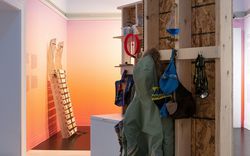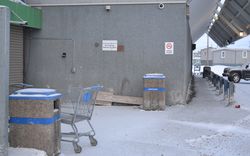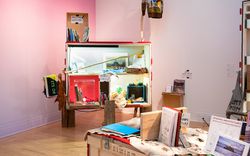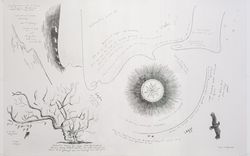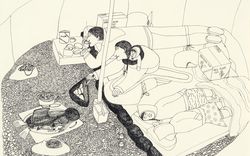Bearing Witness
A conversation between asinnajaq, Geronimo Inutiq, Nicole Luke, Taqralik Partridge, Jocelyn Piirainen, Tiffany Shaw, and Laakkuluk Williamson Bathory
The following conversation took place in June 2022 on the occasion of the opening of ᐊᖏᕐᕋᒧᑦ / Ruovttu Guvlui / Towards Home. In addition to a video recording, which also includes Ella den Elzen, Francesco Garutti, and Rafico Ruiz, a shortened transcription of the conversation is presented here.
What does it mean to you to be part of this project, and to see this project presented here at the CCA?
- JP
- I will start by saying that as a co-curator, I was very grateful to be working with past collaborators like Taqralik, Laakkuluk, and asinnajaq, and form new connections with Tiffany and Nicole. It was an incredibly impactful project to work on, to bring all our voices to this exhibition.
- LWB
- I tend to take things very literally. I heard from Taqralik that the name of the show is ᐊᖏᕐᕋᒧᑦ, Towards Home, and I thought, okay, Taqralik, you have to come to my home then! It just made perfect sense to actually spend time in a home, to think and to collaborate and to create the work that we have done together. And I come from extreme privilege as a person who owns my own home in Iqaluit, whereas in most of Nunavut, the average income is $20,000 per year and 70% of all preschool children experience food insufficiency. It was extremely important for me to be able to talk about how home is taken away from so many people in their own homeland.
- TS
- Growing up, I never felt that places were reflecting my family, and I wanted to make an impact in that way. I’m from Edmonton, Alberta—my family is Métis—and I remember when I was five, my mother drove me past a Douglas Cardinal building: Saint Albert Place. I knew that it looked so different from the environment that I was around in Edmonton, and it looked extraordinary. I knew that I wanted to be part of that place. I wanted to imagine new futures.
That’s why I became an architect: to see myself in these spaces with my family. Architecture often misses the mark on who it’s serving, so exhibitions like this are very meaningful to me because I look at things from a perspective that is often not allowed to have a space. As the exhibition designer, I’m here to talk about what the feeling is when you come into the building, and to make you feel safe, fed, clothed, because that is the thing that my family deals with on a daily basis. And I know that I am not alone. - NL
- Throughout this process it’s been great getting to know everyone, and to be able to work on the Futurecasting workshop series has been an amazing experience that I hope will cause a ripple effect within everyone’s communities and the work that they do. To me, that’s what Towards Home is: creating an environment that can be understood at a personal level, but also making people aware that we all deserve a home, we all deserve to feel safe and to look forward to many opportunities in our own development.
- a
- I was happy to be invited to be on this project, and specifically to be invited to work with an architect, Tiffany, to imagine space. I’m a very curious person and very inspired by lots of things, and one of those things is architecture. What’s really special about being invited into this space specifically, and being able to work with Tiffany, is that so many of us can be so curious and inspired by lots of things in the world but never get the opportunity to explore them. That’s what I’m grateful for, and what’s special about being here is being able to explore something that would have been difficult otherwise.
- GI
- Making art is something that I do, whether professionally or not. My community includes all sorts of classes and ethnicities and cultures, and it’s always complex for me to make art related to identity politics in institutional contexts. I come from another end of the spectrum in terms of the privilege of having a home. I’ve lived on the streets at one point in my life. Some members of my community make street sculptures, and they sell their sculptures to meet their basic needs.
We try to medicate our social problems, which are quite complex. For me, housing doesn’t necessarily mean a safe place, because in the past, these constructions have not always been safe for close members of my family and for me. That means that I have experienced a lot of marginalization. That being said, this is an excellent opportunity for me to express myself creatively in a context where I have a lot of technical support, but also academic support. Conceptualizing ideas around my nucleus.
It’s not my work to sell an image, it’s my work to make an image. And my image is quite personal, subjective. My creations are artistic whims. I’m looking for a pared-down sense of expression, to reach out to a community. And a community starts with a family; it includes my genetics, my culture. I’m a city-dweller, so I try to make my art a place of reflection, a time when we can have experiences outside our routine, outside the status quo. Through art, I find the feeling of community that I had lost, in a way, through the violence of my own personal story, the cultural heritage of colonization. It’s not always equal for everyone, but here through artistic expression, we’re all on the same page. - TP
- This is not the first time that I’ve worked with co-curators, and some of them I’ve worked with before. But it’s always surprising to me how generous people are with their time and their knowledge and just how much I learn from other people of all ages. I was also thinking recently about how much of this exhibition invites the visitor in. asinnajaq’s installation is a place, you can sit in there. You can be in there. And you want to be in there. And with Geronimo’s installation it’s the same thing, you can hear the radio and it’s very interactive. It’s not very typical to find in an exhibition.
- TS
- Carola also asks for offerings to come and be provided in the bowls.
- TP
- Exactly. There are all kinds of places to sit and just experience things at a slower pace, and I think that’s very special. It goes along with our idea that we wanted it to be welcoming, and everybody converged on that on their own, without us saying “okay we want you to do this.”
What are you hoping that audiences take away from visiting the exhibition?
- JP
- When we were first coming up with the idea of what the show would be about—just as the pandemic was starting—it did take us a while to figure out the themes that we wanted to explore. At that point, we really wanted to express the idea of how important the land is around us, especially for those living around the Circumpolar North, how much of a connection Indigenous folks have with the land. But also asking what the future of building in the North will be. I think that is another important question for people when they are going through the exhibition space, to think: how are we going to build in the North?
- a
- I think we made a space that has lots of ideas in it, and that space is there to help prompt people to think for themselves what home is. In my work, I’ve thought a lot about what home means to me, what makes my home and how it’s made. And then as I’m going about my life, I have valuable information that helps me be a human and that helps me get what I need to feel comfortable and feel safe. I hope that everyone coming to the exhibition will take time to reflect on what that means for them individually.
- LWB
- I really wanted for people to take away the idea that Taqralik and I are women in our 40s and we have been homes. We have carried so many lives inside ourselves and created homes for all our children. As Inuit women, the way that we look, the way that we sound, the way that we conduct ourselves is very much appreciated and needed by everybody. We are a hearth. And our looks are sought after. So aesthetically, that’s what I wanted people to take in: that we are ourselves, as 40-something-year-old women.
With our content in the exhibition, we’re dealing with ourselves, so I wanted to create a situation where Taqralik and I were in conversation with each other; where I’m bearing witness to what she has to say and she’s bearing witness to what I have to say. And that idea of bearing witness being as much institutionalization as we can muster as Inuit artists that don’t necessarily have a home in our homeland. But that bearing witness to one another is also a way of inviting visitors to sit there and think their own thoughts while they take in the stories that we’re telling them. I want people to feel welcome to be themselves as they think and watch each of us interact with one another. - TP
- My work, whether it’s curatorial work or writing or art, is always about questions. I don’t necessarily know what the answers are, but I want to raise questions in other people’s minds. We have some central questions that we settled on for this exhibition and I’m hoping that when people see the work, they have more questions, not only about Inuit, about Sámi, about Indigenous people of the North, but also about their place in this system that we all live in.
The other thing that I want people to take away is that Indigenous artists, architects, people, and community members belong in these spaces. We’re not just guests who get a lucky chance. These spaces, all the resources that have gone into building the riches of this world, and especially of this country, have come from Indigenous lands and that they should be re-distributed or re-deployed within Indigenous communities and towards the benefit of Indigenous peoples—among other people, but of course I’m always having Indigenous people and Inuit especially on my mind.
What do you hope to see for the future of home?
- GI
- I’d like to have a home. And I’d like it to be a place where I could have a musical instrument.
- TP
- As you know, many, many Inuit live away from Inuit Nunangat, and that’s not going to change any time soon. I would love to see a lot more affordable housing for Inuit in urban areas. It’s very hard to find a place in Ottawa or Montréal for example, because of racism.
But the other thing I would love to see in the future is access for Inuit living away from the North to Inuktitut language classes, programs, and cultural things, and much more access to being able to go up North. And a lot more collaboration between Inuit working in the South and Inuit working in the North, especially in the arts field. I feel like there’s an artificial divide between these regions, and it really has to do with colonial ideas of putting things into silos. It’s harmful to our communities to have these kinds of divides. - NL
- For me, two things that will be huge giants to face in my line of work in Arctic architecture are fostering safe spaces and having housing units that are suitable for large or multi-generational families. Creating these spaces is about more than just a budget, more than just a policy, but budgets and policies are what you have to work within. I want to try my best to be creative about those challenges.
- LWB
- I’ll talk about one specific dream, about a kitchen where you can take apart a whole animal and make every single dish out of it and look after the skin and feed your family and have people come in to tend to the skin and sew with you and create realms of spiderwebs of mental health and goodness by just having a kitchen that is culturally appropriate to us. Just one example.
- TP
- Bigger porch, right? You talked about a bigger porch too.
- LWB
- And a new porch!
ᐊᖏᕐᕋᒧᑦ / Ruovttu Guvlui / Towards Home was co-curated by Joar Nango, Taqralik Partridge, Jocelyn Piirainen, and Rafico Ruiz, with Ella den Elzen as Curatorial Assistant. The exhibition is currently on view in our Main Galleries and runs until 26 March 2023.
